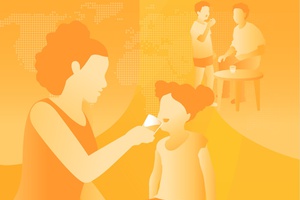WHO publishes updated list of priorities for paediatric formulations of TB medicines
WHO publishes the report of the second meeting of PADO-TB2 group providing an updated list of priorities for paediatric formulations of TB medicines.
5 June 2024 | Geneva -- The World Health Organization’s (WHO) Global Tuberculosis Programme has published the report of the second meeting of the Paediatric drug optimization for tuberculosis (PADO-TB2) group, that provides an updated list of priorities for paediatric formulations of TB medicines.
PAediatric Drug Optimization (PADO) exercises are convened by the WHO for various diseases to accelerate access to optimal formulations in the context of small markets for medicines for children.
“As the market for paediatric TB medicines is small, it is critical to avoid fragmentation and ensure the most needed formulations for children are prioritized for research and development and made available as soon as possible” said Dr Tereza Kasaeva, Director of the WHO’s Global Tuberculosis Programme. “Optimization of paediatric TB medicines contributes to the achievement of the targets for ending TB in children and adolescents set at the second United Nations High-level Meeting on the Fight Against TB in 2023 and is part of the key actions in the Roadmap towards ending TB in children and adolescents, third edition”.
The second PADO-TB meeting (PADO-TB2) considered the latest WHO recommendations on drug-susceptible TB, drug-resistant TB and TB preventive treatment, as well as recent developments in new TB medicines and formulations made available since February 2019, results of clinical trials, pharmacokinetics and pharmacodynamics studies, and advancements of key medicines in the TB research and development pipeline.
The meeting report summarizes the discussions and the main outputs of the PADO-TB2 meeting:
- The PADO-TB2 priority list, which contains priority formulations to be investigated and developed in the short term (3–5 years) (rifapentine 150 mg scored, dispersible tablet; rifampicin 100 mg scored dispersible tablet (tentative listing) and moxifloxacin 100 mg dispersible tablet (palatable)), and formulations that may be developed in the longer term but for which it is essential to flag importance (pretomanid);
- The PADO-TB2 watch list, which contains promising candidates for investigation and development for children, within a time horizon of 5–10 years (all compounds in or shortly entering phase II; long-acting technologies; oral dispersible film/strips of rifapentine-including products); and
- The list of priority research questions to address to promote future TB medicine optimization work for the paediatric population.
The outputs of PADO-TB are used by WHO and other stakeholders to provide clear messaging regarding the development of priority paediatric formulations of TB medicines. All children with TB or at risk of TB are expected to benefit from having access to formulations of TB medicines that are suited to their needs.
The WHO Global Tuberculosis Programme has convened PADO-TB meetings since 2019. These meetings have resulted in the development of a paediatric formulation of rifapentine, which was prioritized by PADO in 2020, and which became available in November 2023.
Source: WHO


